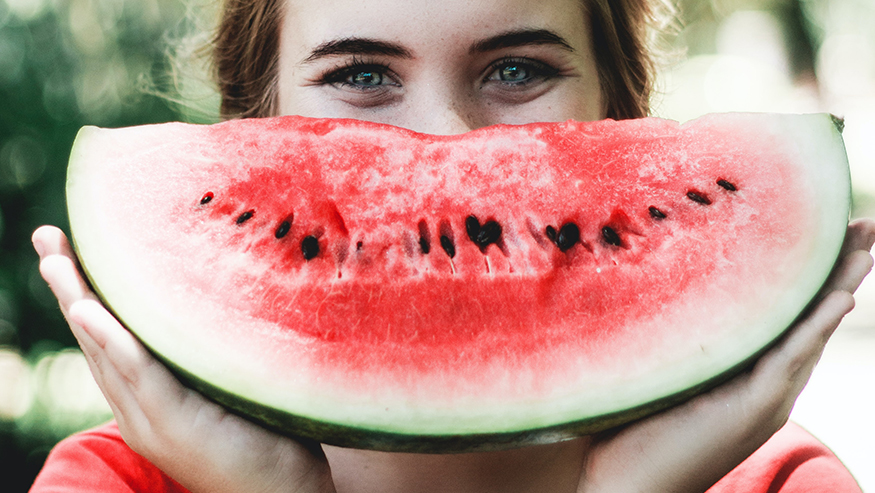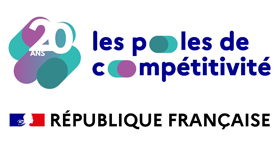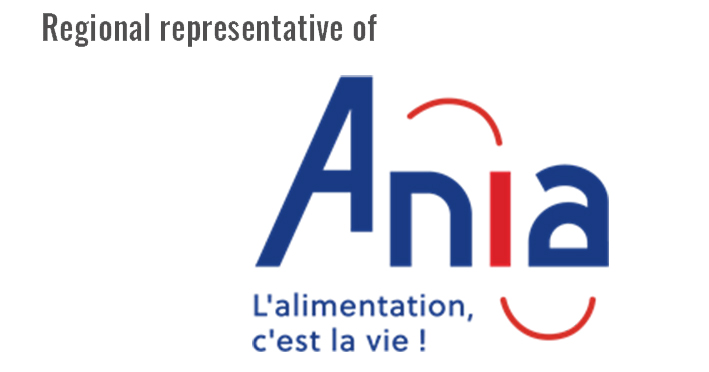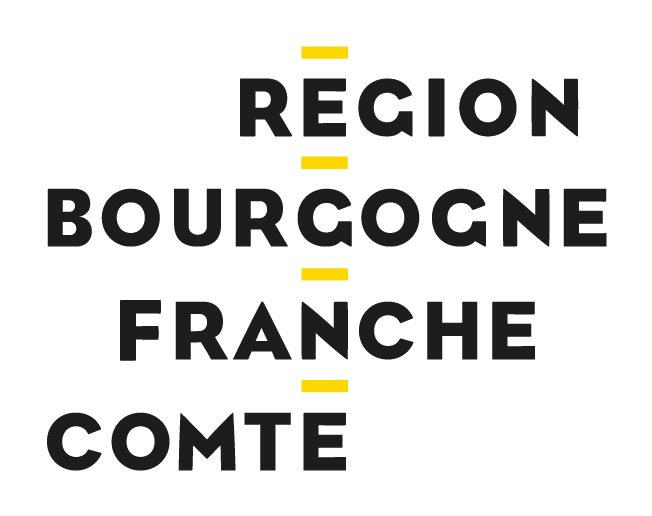20 May 2021 / The experts of the Vitagora ecosystem / Vitagora publication / Science and technologies
Measuring the links between food and emotion... using emojis

The emotions aroused by eating a dish or food product are a recent area of study, measured primarily by self-assessed questionnaires. Understanding how children's food preferences are formed, including the role played by emotion, is an important area of focus in the fight against childhood obesity. So how can we assess the emotions they feel while eating? The use of emojis is being explored as a part of a large-scale European project.
Why this should interest you?
- At a European level, 18.2% of children are overweight - and 3.9% are obese (source). Each year, these figures are growing by 400,000 and 85,000 children per year respectively.
- Childhood obesity is linked to the appearance and development of various pathologies in adulthood: cardiovascular diseases, insulin resistance and diabetes, musculoskeletal disorders, certain cancers, etc.
- Various means of combating obesity have been deployed by public authorities across Europe: incentives to eat healthily, nutritional information, etc.
- The emotional dimension of food - and its role in food choices - remains an area of study to be explored.
- The emoji (or “smiley”) represents a relevant tool for measuring emotions to be deployed in research on children’s nutrition.
Emotion and food are closely linked. It even appears that emotions can reliably help predict food choices - according to some researchers, it is even more than a product's price, availability or labels of quality. However, we are still some way off finding the means to objectively measure the emotions aroused by food.
While childhood obesity is increasing everywhere in Europe (it currently concerns more than 18% of European children), 11 young researchers are developing innovative tools as part of the EDULIA project, to remove the barriers hindering the adoption of a healthy diet by consumers. The ambition of these doctoral students is to identify new approaches to encourage children to like and deliberately choose healthy foods, and thus develop healthier eating habits in the long term.
Among the many studies carried out, one concerns the evaluation of the emotions produced by food in order to better understand the motivations behind children's food choices. The originality of this research lies in the measurement tool used: emojis (or “smileys”).
The EDULIA project

The European project EDULIA, a program funded by the European Commission as part of the H2020 program, addresses European society’s urgent need to find new answers to the growing problem of obesity, in particular by promoting a healthier diet from childhood.
EDULIA is a European multidisciplinary and intersectoral research and training network, integrating 11 doctoral students. EDULIA's ambition is to train a new generation of researchers, endowed with highly specialised skills in complementary fields relating to children’s dietary choices. To go beyond a classic approach of teaching children "what is healthy", and based exclusively on questionnaires and field experiences, this project will explore positive approaches, such as positive marketing or nudging strategies, to focus on social interactions between peers and families, to study the role of sensory and non-sensory parameters on food choice and to take advantage of positive sensory characteristics of foods that can promote the choice of a healthy diet.
Applied knowledge and practical advice will be provided to both the food industry, the general public and policy makers in the European Union. In order to effectively guide applications for the food industry, Vitagora is a member of the Advisory Board of the EDULIA project.
The role of emotion in food choices
"It is important to study children's emotional reactions to food: it can help to better understand the factors of food choice compared to the traditionally studied criteria, such as taste," explains Julia Sick, one of the doctoral students working in the framework of the European EDULIA project.
What links are we talking about?
But the links between emotion and food are numerous. On the one hand, emotions can influence what consumers want to eat - and how much. On the other hand, what we eat can give rise to emotions such as happiness, sadness, joy, etc. If the "emotions" => "food desires" link has already been widely studied (in connection with obesity or bulimia, for example), the links between "food" => "expression of an emotion" have not attracted the attention of researchers until more recently.
Emotions: a reliable predictor of food choices
In 2014, works published by Dalenberg (Dalenberg JR, Gutjar S, Ter Horst GJ, de Graaf K, Renken RJ, Jager G - PLoS One. 2014; 9 (12): e115388) discussed the importance of consumer emotions in predicting food choices, based on hedonic scales. In 2015, research conducted by Gutjar confirmed the importance of the role of emotions aroused by food in predicting food choices more accurately than product satisfaction (Gutjar S., De Graaf C., Kooijman V., De Wijk R.A., Nys A., Ter Horst GJ, et al. (2015b). The role of emotions in food choice and liking. Food Res. Int. 76 (Pt 2), 216–223. 10.1016/j.foodres.2014.12.022).
In 2016, Michaël Flacandji's thesis led by CREGO revolutionised studies in the analysis of consumer behaviour by focusing precisely on three components of the shopping experience: upstream, the heart and, a posteriori, memories. Without questioning the concept of consumer satisfaction, Michaël Flacandji highlighted the importance of memories. Loaded with strong emotions and values, memories are, according to Michaël Flacandji, much more predictive of consumer loyalty than satisfaction (linked to “objective” criteria – price, for example), and their impact is longer lasting. Michaël Flacandji's thesis (available on this link – in French) received the prize for the best French-language thesis in marketing awarded by the French Foundation for Companies Management Academic Education (FNEGE, its acronym in French) and the French Association of Marketing.
How to assess the emotions aroused by food?

The tools traditionally used
An article published in 2018 in Frontiers in Psychology (link here) provides a comprehensive overview of the measurement tools currently used by research to measure emotions aroused by eating: 101 articles assessing consumer emotions, published between 1997 and 2016 and providing 59 different measurements, were included in this publication. In these tools, more than 60% of the tools are based on self-reported assessments and questionnaires.
What about "emojis"?
To remove certain barriers in connection with these questionnaires, researchers have recently become interested in the use of “emojis” (or “smileys”). However, emojis are not yet considered a reliable alternative to "text-based" questionnaires.
In 2020, researchers Sara Jaegera (The New Zealand Institute for Plant & Food Research Limited), Leticia Vidal and Gastón Ares (both from Sensometrics & Consumer Science, Pando Technology Centre Institute, Faculty of Chemistry, University of the Republic, Uruguay), launched a call for more work on the subject. While recognising the limits of the use of emojis as measurement tools (the ambiguity of interpretation, for example), they highlight 2 clear advantages: the familiarity of consumers with emojis (excluding elderly consumers) and their interculturality - an undeniable asset in the context of experiments where translation or interculturality can present an obstacle.
And for children?
If the measurement of emotions linked to food products in adults is an area of study (even if it is still recent), it remains little explored in children. However, as eating habits are built from childhood, it is essential to understand, from an early age, how choices and preferences are formed for one diet or another.
Julia Sick, a doctoral student in the EDULIA project, explains the importance of deploying specific tools to carry out such studies: “Sensory research on children's nutrition requires age-appropriate tools because they differ from adults in many aspects of development. The tools should be attractive and easy to use, without requiring too much instruction or training.”
She confirms the relevance of emojis: “Emojis appear as attractive images to express emotions or feelings. They are already commonly used digitally, for example, on social media and smartphones, by teens and pre-teens.”
Concerning the age-appropriateness of emojis as a tool: 68% of 9-13 year olds regularly use emojis on social networks. A simple and intuitive concept, their use implies created the structure of a game and is an advantage for young children (with reduced verbal skills and limited vocabulary). It is also a non-verbal way of conveying meanings and feelings.
Emojis: a new measurement tool for pre-teens?

Emojis at the heart of EDULIA's work
Faced with the interest that emojis represent as a measurement tool, but faced with their limits, Julia Sick took an in-depth look at the subject for EDULIA. The objective of Julia Sick's study is threefold:
- explore the emotional significance of emojis that pre-teens find appropriate to describe their eating experiences;
- develop a self-evaluation measurement tool to measure emotional reactions to food products;
- test this self-evaluation measurement tool in pre-adolescents on existing food products.
A first study was carried out at the start of 2020. In total, 7 food contexts were submitted to a cohort of 86 children, aged 9 to 13: a favourite dish/food, a least favourite dish/food, a breakfast, a snack, a dinner, a birthday and "novel food experience".
First, these 86 children were asked to recall the foods they had previously eaten in these eating contexts. Then, they were asked to express their emotion from this memory by selecting the most appropriate in their opinion from a list of 92 emojis.
This first step made it possible to demonstrate that the children were quite able to use specific emojis to describe their emotions concerning foods in their memories. The study also made it possible to elaborate a list of 46 emojis adapted to the emotions aroused by food. Finally, two interesting points about the use of emojis by pre-teens should be underlined:
- A different use according to gender. For example, girls chose heart emojis more frequently than boys.
- A different use according to age. Younger children (9-11 years old) tended to choose emojis directly related to food, unlike older children (12-13 years old).
To better understand the semantic interpretation of emojis
In a second study, in which 162 pre-teens participated, Julia Sick investigated the meaning of emojis used to develop a tool for measuring emotions. She then mapped the 46 emojis previously identified according to three psychological scales related to emotion:
- Valence: a scale ranging from pleasant to unpleasant
- Power: a scale from dominant to submissive
- Stimulation: a scale from strong stimulation to weak stimulation
Example of emoji mapping according to 2 axes (valence and power):
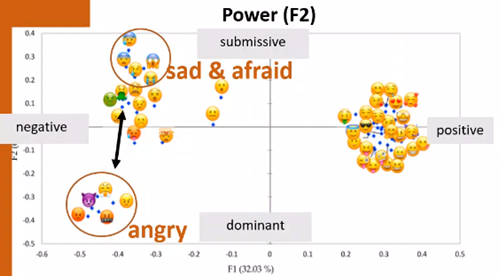
In parallel, pre-teens were asked to verbally describe the emojis used, and, conversely, to link an emoji to a specific word related to the emotion. Only the words collecting more than 40% of the descriptions were kept in the study.
Thus, the emoji 😎 is described by the following words: “confident” by 50% of participants, “happy” by 49%, “satisfied” and “comfortable” by 44% and “feels cool” to 11%. On the other hand, the emoji 😫 is described by the following words: "dissatisfied" (55%), "sad" (48%), "melancholic" (40%), "disappointed" (40%) "," guilty " (40%).
Thanks to this second study, several lessons can be learned:
- A total of 30 words emerged from the descriptions made by all the pre-teens
- The word "happy" is found in all descriptions of positive emojis
- Negative emojis have a more precise description
- Neutral emojis (e.g. the surprised face) are mostly associated with negative descriptions.
- Older girls and pre-teens (12-13 years old) are better at discriminating positive emojis than younger boys and pre-teens (9-11 years old), possibly related to a finer ability to feel and distinguish between emotions (“emotional granularity”), especially for positive emotions.
- The meaning of emojis is probably "learned", culturally determined and context dependent.
Result: the development of a questionnaire
Based on these results, a questionnaire was developed to replace the use of vocabulary by the use of emojis. A "circumplex" model has been developed, grouping the emojis into 17 groups of two, according to their dimensional and semantic meaning:
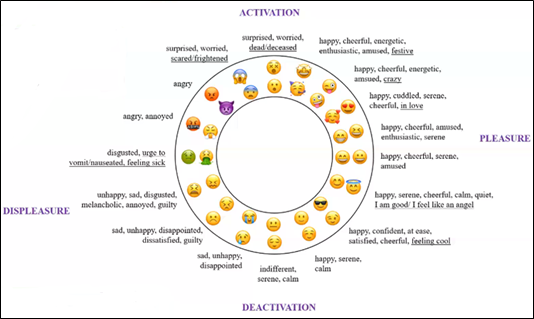
Several types of questions were included in the questionnaire:
- Multiple choice questions, giving participants the ability to select multiple groups of emojis to answer a question. For example, "How do you feel when you think of pizza?"
- For example, to situate how the participants feel on a scale from “not at all” to “totally” and concerning one and another group of emojis.
The questionnaire was tested at the end of 2020 with 148 Norwegian pre-teens and concerning 28 real foods, including fruits, vegetables but also desserts and fruit juices.
This test confirmed the interest of using emojis to better understand children's food choices. As a matter of fact:
- The use of groups of emojis makes it possible to obtain a more precise meaning of the associated emotion
- Classifying groups of emojis can help distinguish food products with very similar sensory characteristics
- Teens like to use emojis and happily participate in surveys - which can play a role in recruiting cohorts.
EDULIA: an interdisciplinary and field approach
Many other aspects linked to the development of a “new generation” of research in the service of healthy eating in children are addressed within the framework of the EDULIA project. Carried out across Europe, all these research programs have the specificity of being based on observations and experiences in the field, in contact with cohorts of children and parents.
Impact of parenthood on eating behaviours
For example, a study carried out in Denmark and France, with the active participation of the Dijon Centre for Taste and Feeding Sciences (CSGA, its acronym in French), looked at the eating behaviours and perceptions of 16 Danish parents and 14 French parents.
With more than 35 hours of interviews and more than 500 pages of speech analysis, the study reveals that parenthood represents a window for modifying the eating habits of adults: either a possibility of improvement or of a recession. Parenthood would therefore be the opportunity to establish effective strategies and public health messages aimed at changes in eating behaviour, on condition that "strict rules of nutrition" are avoided, which increase stress levels and lead to a refusal of information, but on the other hand promote the perception of personal efficiency and the empowerment of parents (read more on this link).
Do you want to go further?
Related articles
- Close-up on food trends: Emotions: a marketing approach to explore
- Experts of the Vitagora ecosystem: Understanding consumer experience to build brand loyalty
- https://EDULIA.eu/
Keywords
Diet, food choices, food preferences, research, children, pre-teens, emotions, emojis, questionnaires
Find out more

To find out more about the EDULIA project and it's food industry applications, contact Eugénie Cornu: eugenie.cornu@vitagora.com.
Following her studies in the area of innovation and biotechnologies, Eugénie joined the Vitagora team in the role of international project manager. A globetrotter and polyglot, she provides support for companies in the set up and running of European projects: identification of opportunities and project calls, international partner searches, and funding opportunities.




 Home
Home
